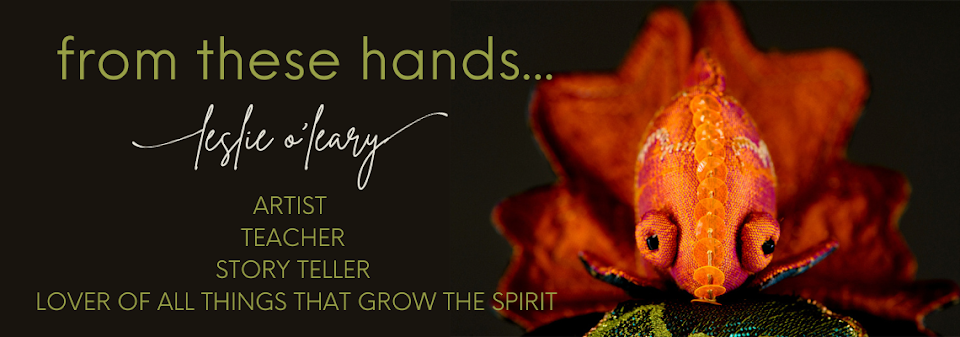Printing on Fabric*
I love the printed word on my pieces for many, many years.
I have found this to be one of my signatures characteristics of my dolls! Even one word can change the feel of a piece.
And so, for my Alma series, a written Spanish Blessing is so fitting...
Amor
Dios te bendiga y te dan paz y amor,
corazón a corazón y mano a mano
Alma
Benita
Love
God bless you and give you peace and love,
heart to heart and hand in hand
heart to heart and hand in hand
Blessed Soul
 |
| hand-sewing band into place |
Design Concept: I also placed the Blessing so that heart to heart and hand in hand faces to the front on the skirt- just really liked that!
Step 1: Supply List
-Fabric
- preferably a tightly woven thin fabric such as silk or cotton
-Freezer paper
-Freezer paper
-One sheet
of 8 1/2" x 11 computer paper
-Tape -INKJET Printer*- this will in no way work in a laser printer. As it is my husband found out I was running farbic though the inkjet- so I bought my own for my studio! I got it on special for around $80-90 and it has worked out nicely! HP Officejet 4500 ratings are fair on this one but I have had really no trouble.
-Tape -INKJET Printer*- this will in no way work in a laser printer. As it is my husband found out I was running farbic though the inkjet- so I bought my own for my studio! I got it on special for around $80-90 and it has worked out nicely! HP Officejet 4500 ratings are fair on this one but I have had really no trouble.
-Rotary Blade, ruler, and cutting mat
Step 2: Cut to Size
Cut a piece of
fabric to 8.5"x11".
Repeat with
freezer paper.
Step 3: Press Together
Place the
fabric wrong side up onto ironing board. Place shiny side of freezer paper down
facing wrong side of fabric. Line up so freezer paper it matches cut fabric.
Step 4: Trim
Trim around all
edge so there are no stray threads.
Re-press if
necessary.
Secure stabilized fabric face up with a piece of tape on top of regular computer paper about 1-inch down from top. Make certain that everything is lined up nicely with no sticky tape sticking out over the edges.
Step 5: Set into printer carriage
Do a test run to check on using a sheet of paper to see which side of the paper your printer prints. I do this by making a small pencil mark in one corner with paper facing up. After I run a test print, I check where the pencil mark is while paper is still in the carriage to confirm if I need to place my fabric up or down.
You now have a
piece of fabric that is supported by the attached piece of freezer paper and the secured onto the computer paper. This
makes a solid grouping to be grabbed by the printer. Treat the finished piece like a regular piece of paper
and stick it into an inkjet printer.
Step 6: Print (with crossed fingers)
I always cross my fingers when I press print..so far so good!
Note: I print in a very large font size. I calculate out
how the font size and the spaces with fit evenly around the skirt. I
arrange the spacing to fit within the 11" length of the fabric to create
lines of lettering "tapes" that can be sewn together with 1/4" seams to
create one band that will end up to fit nicely around the diameter of
the skirt.
Note:
This is a very temperamental process and it may take you several times
to see what works for your individual printer but once you have figured
it out the results are amazing!
Other Dolls
 |
| Butterfly Story Doll with "book" vest |
 |
|
With vest open
displaying Butterfly lore
in Chinese and in
English.
|
 |
| Goldi |
 |
| Just right... |
 |
| Rose- Le Fleur |
 |
French "...that which we call a rose
by any other name would smell as sweet." |
 |
| Snow |
 |
| Mirror Mirror on the wall... |
*Disclaimer: Not all printers can print on fabric, and putting fabric through your printer could damage it permanently. This is an experimental technique, and you should only try it if you understanding that it involves an element of risk.



































